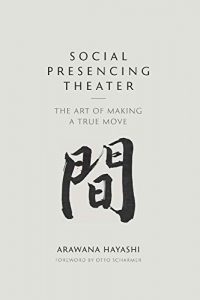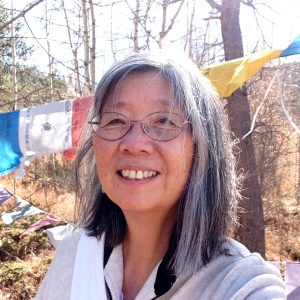Friday
Authenticity in Intention and Action
Social Presencing Theater: The Art of Making a True Move by Arawana Hayashi
Reviewed by Elaine Yuen
 In these busy and distracted times, finding authenticity in intention and action can be challenging. It seems that every moment we are called to react to our world with likes, distrust, or ignorance. Arawana Hayashi’s new book, Social Presencing Theater: the Art of Making a True Move, provides guideposts for navigating the observations, gestures, felt senses, and thoughts that populate a day to day life. Clearly explaining the links between our bodily expressions, feelings, and thoughts, the book also includes contemplative practices that illuminate each chapter. Examples from corporate, medical and community settings demonstrate how these practices have been brought to life. Theater is seen to be not just an evening of entertainment on a stage, but rather the ordinary gestures of the day-to-day, attended with mindfulness and awareness.
In these busy and distracted times, finding authenticity in intention and action can be challenging. It seems that every moment we are called to react to our world with likes, distrust, or ignorance. Arawana Hayashi’s new book, Social Presencing Theater: the Art of Making a True Move, provides guideposts for navigating the observations, gestures, felt senses, and thoughts that populate a day to day life. Clearly explaining the links between our bodily expressions, feelings, and thoughts, the book also includes contemplative practices that illuminate each chapter. Examples from corporate, medical and community settings demonstrate how these practices have been brought to life. Theater is seen to be not just an evening of entertainment on a stage, but rather the ordinary gestures of the day-to-day, attended with mindfulness and awareness.
Developed over many years of teaching and performance, Acharya Hayashi came to the work of social presence initially as a dancer and choreographer, but has utilized her somatic knowledge and creativity to teach workshops that include executives, community organizers, and school teachers through the Presencing Institute.
Social Presencing Theater first invites us to develop a felt awareness of gestures, and their accompanying feelings and intentions, in playful and open-ended exploration. The chapters explore how we might be stuck, frozen, by embodying a gesture and expressing a single word/expression. The chapters then move on to explore how a group or social system might support each participant to first notice, and then bring a felt expression to, a collective and individual statement of body, feelings, concept.
The practices in the book all point to a refined ability to directly notice one’s physical sensations, feelings, and perceptions. First, an awareness of physical arrangements – of oneself as well as the social body of a group – is key. Concurrent with a noticing of physicality is an observation of the felt senses that arise alongside of it. How we make “sense” of this combination – in the moment to moment of awareness – is the third movement of the mind. The practices allow one to develop a pre-conceptual sense of the social field, or environment, and how one communicates and moves through it. As meditation practitioners, part of the practice path is to explore how ‘meditation in action’ manifests for us in our everyday, social lives. I have found Acharya Hayashi’s work to be uniquely able to bring together how body, feelings, and expressions mesh in communication. The chapters progress through a sequence of practices that lead one from individual exploration to collective action. Not only are we invited to explore the personal and individual, but we are also asked to notice the “social field” that we constantly participate in and inhabit.
Each chapter provides an overview and instructions for Social Presencing practices, case studies gleaning insights from workshop participants, as well as commentary of how the approaches of Social Presencing Theater are relevant in “real life.” Although useful as a companion to the Social Presencing Theater workshops that Acharya Hayashi teaches worldwide, it is equally helpful as we must discern and appreciate how our bodies express complex “stuck places.”
There are natural connections of Social Presencing Theater to Shambhala practices of Dharma Art/Shambhala Art and Mudra/Maitri Space Awareness. In Social Presencing, the Shambhala Art practices of perceiving and creating engage with contemporary social issues. The felt sense of the social field in Social Presencing is an organic extension of the energetic qualities of space that are foundational in Mudra and Maitri Space Awareness. I have found the interrelationships of these practices to be invaluable in understanding and appreciating the Shambhala disciplines, as well as contextualizing their relevance in daily life activities.
The simple directness of the forms taught in Social Presencing Theater: the Art of Making a True Move point to the contemplative space that holds our ordinary experience as well as the changing content of words and gestures. Our complex and changing social environments are urgently calling for genuine communication. The practices and understandings laid out in this book go a long way in supporting this investigation.
Elaine Yuen PhD
 About the Author: Arwana Hayashi
About the Author: Arwana Hayashi
Arawana’s pioneering work as a choreographer, performer and educator is deeply sourced in collaborative improvisation. She currently heads the creation of Social Presencing Theater (SPT) for the Presencing Institute. Working with Otto Scharmer and colleagues at the Presencing Institute, she brings her background in the arts, meditation and social justice to creating “social presencing” that makes visible both current reality and emerging future possibilities.
Her dance career ranges from directing an interracial street dance company formed by the Boston Mayor’s Office for Cultural Affairs in the aftermath of the 1968 murder of Dr. Martin Luther King, to being one of the foremost performers of Japanese Court Dance, bugaku, in the US. She has been Co-Director of the Dance Program at Naropa University, Boulder, CO; and founder-director of two contemporary dance companies in Cambridge. MA. She continues to perform in a multi-disciplinary performance ensemble, originating out of Naropa University and the ALIA Institute, where she currently teaches in leadership programs.
Arawana is an acharya (senior teacher) in Shambhala – a global network of meditation centers dedicated to applying mindfulness to “creating enlightened society.” She teaches both meditation and art based on bringing out the basic goodness of individuals, of relationships and of society.
 About the Reviewer: Dr. Elaine Yuen
About the Reviewer: Dr. Elaine Yuen
Dr. Elaine Yuen is a contemplative educator, chaplain, and artist. Formerly Chair of the Wisdom Traditions Department and Professor at Naropa University in Boulder, Colorado, she continues to teach and write on pastoral caregiving (chaplaincy), contemplative education, and Buddhist studies. She hails from Philadelphia where she was an associate professor, researcher, and interfaith chaplain at Thomas Jefferson University.
Elaine has been trained as a healthcare chaplain, and is also a meditation teacher and Upadhyaya (Buddhist Minister) in the Shambhala Buddhist tradition, trained by Chogyam Trungpa Rinpoche.
Elaine enjoys discovering the creative impulse within life’s many activities, be they making pieces of art, caring for elders at the end-of-life, or brewing a proper cup of tea. Her programs often consider the interfaces between the creative impulse and meditation, Buddhism, and contemplative care-giving.
Author Archive
1 response - Posted 08.03.21
Habitual patterns keep us stuck, how do we break free into a fuller version of ourselves? By Halleluiah Strongheart Reposted with permission from Strongheart Leadership. I have often wondered why it’s so hard to change habits. Even when we know what’s best for us, or how we want to ...continue
no responses - Posted 07.30.21
A Book of Luminous Things – An International Anthology of Poetry Edited with an Introduction by Czeslaw Milosz Reviewed by Christine Heming Before you print a poem, you should reflect on whether this verse could be of use at least to one person in the struggle with himself and ...continue
1 response - Posted 07.23.21
Finding Our Way Through Existential Crisis: The Centre for Local Prosperity By Robert Cervelli “We don’t own the land, the land owns us.” These were the words spoken to me by a Mi’kmaw Indigenous Elder. We were talking about the colonial mindset and how dramatically juxtaposed it is ...continue






